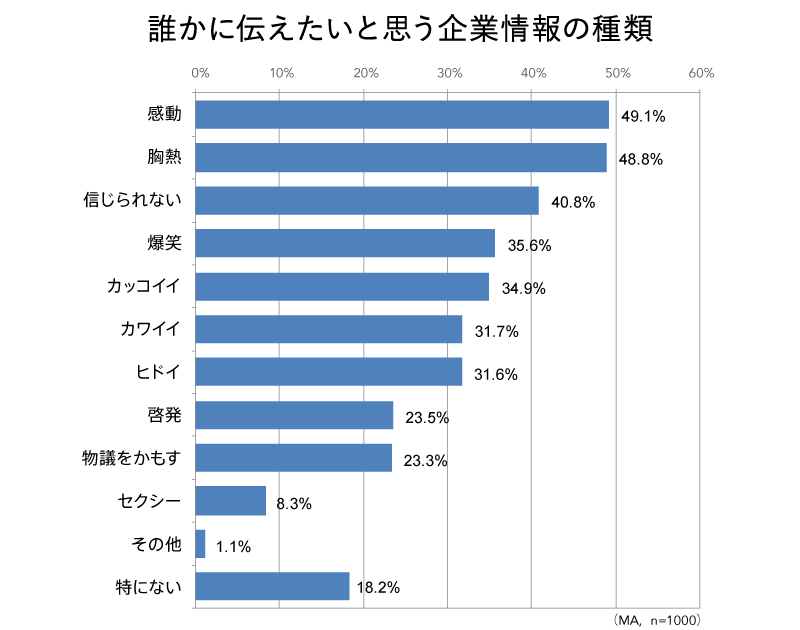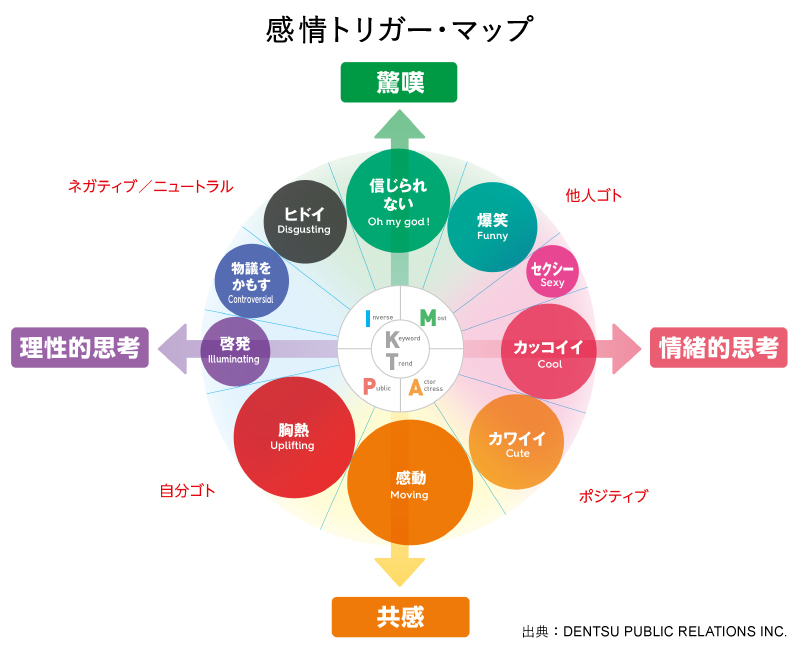
The 2nd " Corporate Appeal Survey 2017 " (Corporate Public Relations Strategy Institute)
The results showed "Inspiration" (49.1%) ranked first, followed by "Heartwarming" (48.8%) and "Unbelievable" (40.8%). Support gathered for content that evokes strong "empathy," content whose story touches the heart and warms the chest, and content that delivers surprise beyond one's imagination.
Incidentally, while "Awful" or "Sexy" may be shareable, they tend to provoke backlash or criticism from consumers. For the purpose of enhancing corporate appeal, they carry high risk and low reward. Caution is advised.
Map emotional triggers to serve as a compass for content design
The result of mapping these 10 emotions is the "Emotional Trigger Map." The vertical axes represent the directionality of emotions: "Awe," which creates a strong, immediate impact, and "Empathy," which reaches deep into the heart and elicits strong resonance. The horizontal axes represent "Rational Thinking" and "Emotional Thinking," with each emotion positioned accordingly.
The size of each emotion's circle is proportional to the numerical results from the previously mentioned survey.

The proportion of each response relative to the total number ofMA surveyresponses(set at 100) is represented by grid lines, and the circle is designed along these grid lines.
Incidentally, the survey also revealed that these "emotional triggers" show trends by gender and age group. Briefly, for eight emotions (excluding "Enlightenment" and "Sexy"), women's scores exceeded men's. By age group, younger demographics showed higher responses for many items, while "Enlightenment" elicited the strongest response from those in their 60s.
Furthermore, the "PR IMPAKT"※ at the center of the "Emotional Trigger Map" is also an indispensable perspective for content design.
Strategic content design through "Emotional Triggers" + "PR IMPAKT"
If "Emotion Triggers" serve as indicators for planning which consumer emotions to stimulate for sharing, "PR IMPAKT" consolidates six angles for information likely to become newsworthy. It models what perspectives make news based on analyzing various real-world news stories.
The name "PR IMPAKT" is derived from the initials of the following elements:
・Inverse (Paradox, Contrasting Structure)
・Most (Superlative, First Ever)
・Public (Social Relevance, Regionality)
・Actor/Actress (Celebrity)
・Keyword (keyword, numbers)
・Trend (current trends, social climate, seasonality) ※ "PR IMPAKT" is a strategic design perspective developed by Dentsu Inc. and Dentsu Public Relations, unique to the Dentsu Group. For details, please see here.
These "PR IMPAKT" elements can be considered in combination with "emotional triggers."
For example, content that stimulates "emotional impact" or "heart-pounding excitement" while simultaneously addressing "Public" (societal) issues tends to have high newsworthiness and is more likely to be shared on social media. Emotions highly compatible with "IMPAKT" are positioned close together within the "map" (Keyword and Trend, applicable to all, are placed centrally).
We recommend using these perspectives as a checklist before releasing content. By strategically designing content that centers on "emotional triggers" while also incorporating the newsworthiness perspective of "PR IMPAKT" – meaning considering how media will cover it – companies can unlock diverse possibilities and opportunities for their information dissemination.







